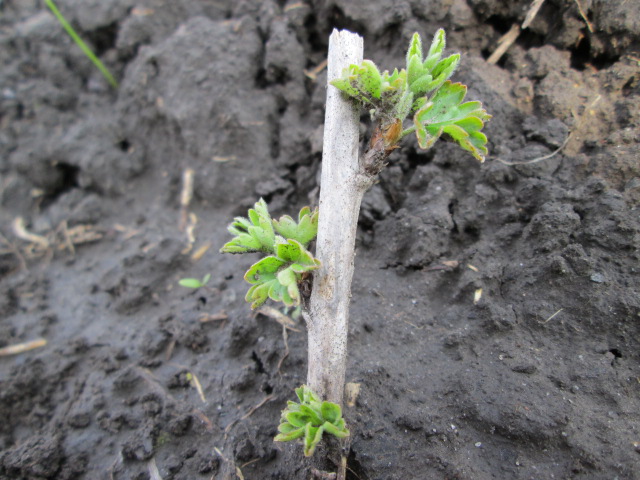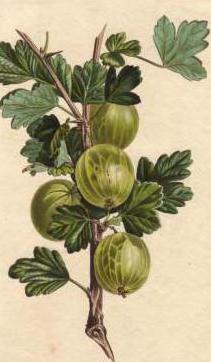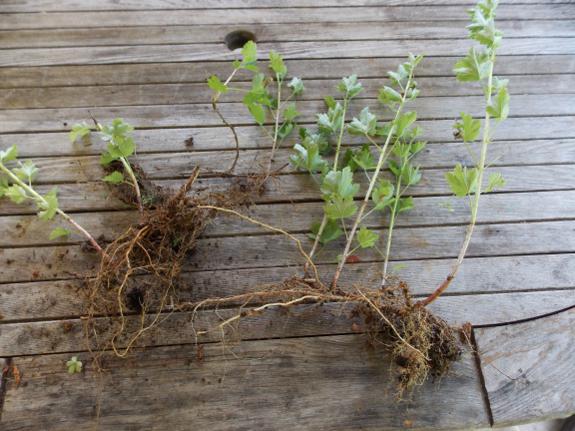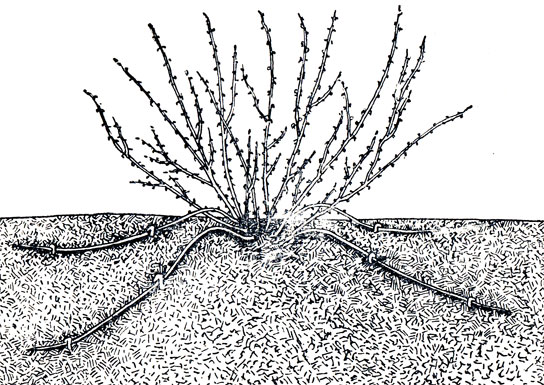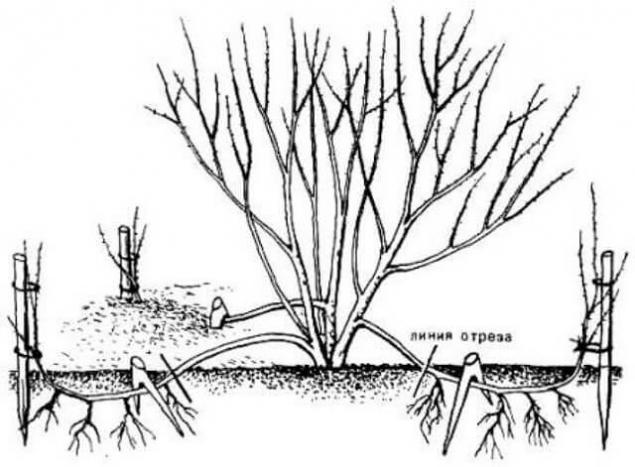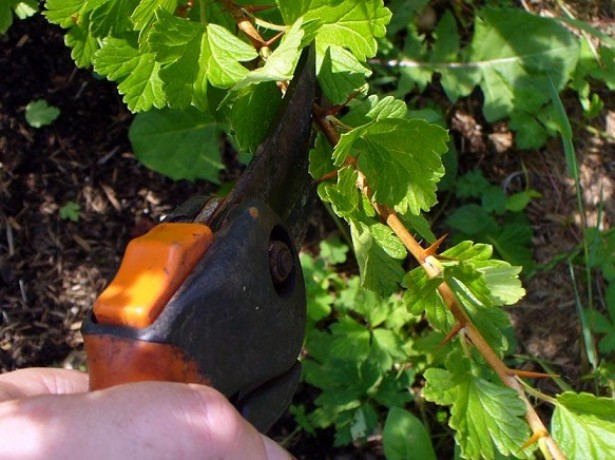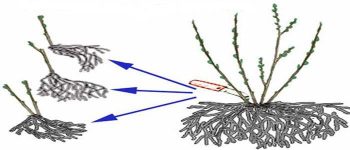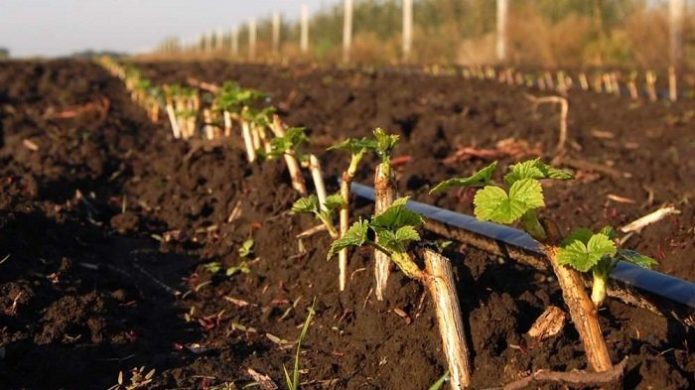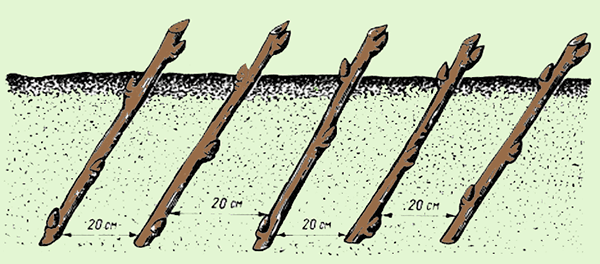Gooseberries, which have become permanent residents of private plots, like any other culture, require care. The importance of sufficient watering, timely weeding and loosening of the soil, and proper fertilization is essential. But when planting gooseberries, it is worth remembering that over time, there may be a need for reproduction of this shrub.
Content
Gooseberry propagation by vegetative parts
Increasing the number of units of planting material is a laborious process that can be carried out in two main ways: vegetative and generative. The greatest efficiency is achieved when the gooseberry is propagated vegetatively, that is, by layering, various types of cuttings, dividing the bush, perennial shoots or grafting.
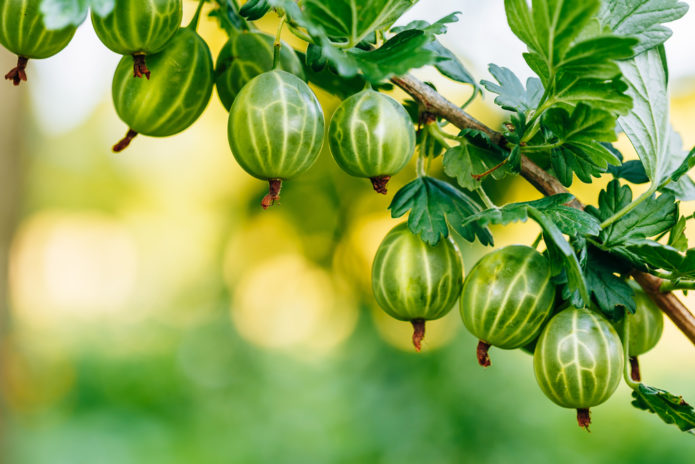
Gooseberry propagation is carried out mainly by vegetative methods, since seed does not completely preserve the quality of the variety
Gooseberry propagation by cuttings
Cutting is one of the most popular breeding methods. This method is suitable for propagation of pure, high yielding, healthy shrubs.
Woody cuttings
Propagation of gooseberries by lignified shoots is practically not used due to their low rooting ability. This method is practiced only on small-fruited varieties and hybrids, American selection and requires a lot of energy consumption for care.
Green cuttings
Green cuttings gained popularity simultaneously with the massive distribution of growth stimulants. This is due to the fact that a competent approach to caring for young plantings allows you to get a large percentage of rooting and in a short time (after a year) have standard seedlings.
Cuttings are cut in June. Often in various sources there is information about the importance of harvesting shoots in the morning due to their saturation with moisture. However, experimentally M.V. Efimov found that rooting of cuttings cut in the afternoon was better. This is due to the abundance of carbon dioxide in the tissues of the plant, which contributes to the survival of the cuttings.
An ideal shoot for harvesting green cuttings is an actively growing shoot, but having begun to lignify, break with a slight crack when bent.
For propagation by the method of green cuttings of gooseberries, the apical parts of young twenty-centimeter lateral shoots are used. In the future, the shoots are cut into cuttings, 6-7 cm long. Each cutting should contain 1-2 internodes and 2-3 leaves. The cut in the upper part is made above the leaf bud, and the lower one is made under the petiole of the last leaf.
For 10-12 hours, the green cuttings are dipped in the lower end into a solution of growth stimulants. Cuttings containing apical bud can be immediately planted in greenhouses, since the tissues of the tops of young shoots contain a large number of natural growth substances. Rooting of cuttings is carried out in specially equipped greenhouses. Much attention must be paid to soil preparation: it is loosened, equalized with a rake and slightly compacted. On top of the soil, it is necessary to pour 3-4 cm of washed river sand, which is also leveled. The substrate prepared for planting is watered abundantly.
Planting cuttings is carried out according to the following scheme:
- between rows - 7 cm;
- between cuttings in rows - at least 4 cm.
Green cuttings are buried in the sand by 1 cm.Immediately after planting is completed, it is necessary to sprinkle the substrate with water from a watering can with a fine mesh nozzle. On sunny, hot days, it is recommended to shade the greenhouses a little to prevent scalding of the cuttings. To preserve the cuttings, they are sprayed with water 2-3 times a day, and in dry weather the number of sprays increases. The sand should also not be allowed to dry out.
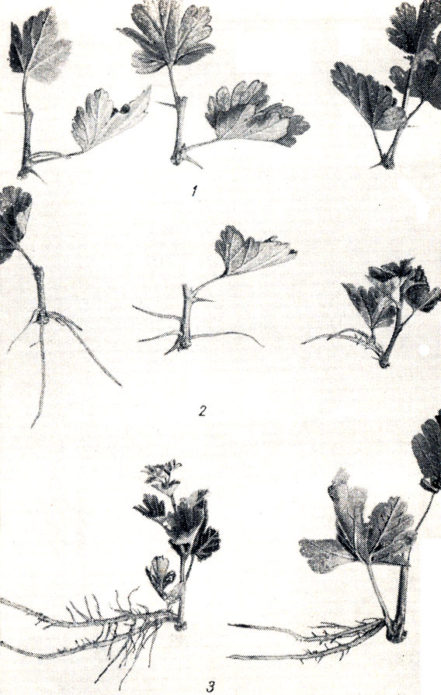
Phases of root formation of green gooseberry cuttings: 1 - formation of callus (influx of root-forming tissue), 2 - manifestation of the first roots, 3 - the initial stage of root branching
The roots of green cuttings usually appear after 20–25 days. From this time on, greenhouses open in the morning and in the evening for a few minutes so that the plantings get used to the drop in temperature. Finally, the greenhouse structure is removed only after the cuttings give a significant increase.
Transplantation for growing young, mature specimens is carried out in early autumn. The soil around the plants is highly moistened and, together with a clod of earth, they are transferred to a new place, sprinkling the planting hole with peat. Weak seedlings are recommended to be left in greenhouses for the winter, then growing is postponed until spring.
Combined cuttings
Combined cuttings are a variety of green cuttings. Their distinctive feature is the presence of a lignified part of the shoot of the last year, or, in other words, the "heel". A cutting tool is not required for their preparation, since such cuttings break off, which is why the heel is formed.
The technology of planting and growing combined cuttings does not differ from green cuttings: the length of cuttings does not exceed 7 cm, and the planting is done in wet sand in greenhouses. The first roots appear after 15 days.
Experiments show that the survival rate of cuttings with a heel is much higher than that of green ones.
Gooseberry propagation by layering
The propagation of gooseberries by layering is based on the ability of this species to actively form a root system on young branches sprinkled with earth.
Horizontal layering
For growing gooseberries with horizontal layers, it is recommended to use young or rejuvenated bushes. Also, a large volume of layering is provided by the so-called uterine bushes. They are very thinned gooseberry specimens, where only 3-4 fruiting branches are left. Every year, such bushes are overgrown with many annual shoots, as well as lateral growths of branches of the previous year - such branches give the strongest layers.
The cultivation of cuttings should take place on fertile soils, which is why organic and mineral fertilizers are annually introduced into the gooseberry tree trunk circle. In early spring, when the soil warms up and dries up a little, it is dug up and loosened, mixing with fertilizers. After soil preparation, strong annual shoots or biennial branches with strong lateral growths are laid in grooves and fixed along the entire length with hairpins. The tops of the shoots are pinched.
The branches, bent to the ground, quickly form young green shoots, after reaching 10–12 cm they are half-sprinkled with a mixture of compost or humus and earth (1: 1). The procedure is repeated after 15–20 days, when the shoots have added about 15 cm in growth. Before backfilling, the soil is shed.
The layering can be done in two ways:
- Rooted branches are cut off from the main bush in the fall, dug up and divided into planting units, which must have their own branches. Then they are transplanted for growing.
- Rooted branches are left near the mother bush for one more season. With the onset of heat, they are again sprinkled with a substrate and in the fall they are divided, seated in permanent places.
Vertical layering
The method is suitable for age bushes that require rejuvenation. Obtaining vertical layers is carried out by hilling gooseberry bushes. Why, in early spring, the bush from which the layers will be taken is thinned out or cut shortly, at the same time fertilizers are applied to the soil. Due to the manipulations carried out, the bush will form a large number of young shoots from the very base.
With this method, it is important to take into account the peculiarity of the wood: the younger it is, the faster root formation occurs. Therefore, the bush is cut.

The scheme of propagation of gooseberries by vertical layers: a - the formation of green shoots on the cut branches, b - rooting in the hillock of young shoots
When the shoots reach 20 cm in height, they are sprinkled with compost or earth up to half, pushing them apart from each other. After about a month, the procedure is repeated, after watering the soil. In good weather conditions and in the presence of sufficient moisture, the cuttings form a good root system until autumn.
A year later, in the spring, the hillock is removed, and the rooted shoots are separated from the mother bush, planted and grown. Before planting, they are cut so that 2-3 buds remain above the roots. Transplantation to a permanent place is possible for the next year.
Arcuate layering
The method is a cross between propagation of horizontal layers and vertical ones.
To obtain arcuate gooseberry layering, young shoots are bent to the ground and fixed in the center with a hairpin. After that, the places of fixation are sprinkled with humus and hilled. The apical parts of the shoots, which are above the ground, are slightly shortened and tied to a peg.
During the summer, the hillock is watered, preventing it from drying out. By the end of the season, the cuttings form their own strong root system. They are separated from the mother liquor and transferred as full-fledged seedlings to a permanent place.
Video: propagation of gooseberries by arcuate layers
Gooseberry propagation by perennial shoots
Reproduction in this way can be timed to the spring or autumn pruning of gooseberries, during which the bushes are thinned out. The cut branches are laid in shallow grooves and covered with fertile soil so that young growths and the tip of the branch itself remain above the ground.
The soil above the branch must be regularly moistened. In the fall of next year, the buried branch is divided into several seedlings and planted for growing.
Gooseberry propagation by dividing the bush
The way that allows you to get the fastest result from reproduction is a fruiting bush. The division of the gooseberry bush can be carried out from mid-October to April. It is very important to prepare the shrub for the procedure: for this, in the year preceding breeding, the gooseberry is planted on a stump, that is, it is heavily cut off. In the next season, the plant begins to form new green growth, it is dug up and divided into parts with a sharp garden tool.
Root cuts must be sprinkled with crushed coal. Delenki of gooseberries, each of which has its own shoot, are transplanted immediately to new places, in planting pits, covered with fertile soil.
Gooseberry grafting
Gooseberries rarely reproduce by grafting, since the shoots formed at the roots of the plant are almost always non-varietal. Gooseberry grafting is most often carried out on red or golden currant seedlings:
- Currant seedlings are grown from cuttings of annual shoots in pots or greenhouses, which are transplanted into pots at the end of August. Throughout the summer, containers with cuttings are kept dug into the ground, and for the winter, the pots are moved to basements or greenhouses, covered with straw.
- In March, currant seedlings have a length of 53 to 71 cm. They are brought into a greenhouse, where gooseberries are grafted using the improved copulation method: a wedge-shaped cut for a scion and a wedge-shaped split for a rootstock are combined and tightly fixed with elastic material.
- The gooseberry graft is overgrown with shoots that need to be pinched to get a thicker crown. The currant stock also produces shoots below the grafting site, which must be broken out.
- The grafted plants are planted in open ground in May.
Seed method of propagation of gooseberries
It should be remembered that when trying to propagate gooseberries by seeds, there are often cases when the propagation unit does not have all the varietal characteristics of the parent plant.
The loss of the signs of the mother plant in gooseberries is associated with its ability to cross-pollinate - the transfer of pollen from one variety to another leads to the fact that the seedlings acquire new properties, often undesirable. In addition, most modern varieties are hybrids that receive both their own characteristics and hereditary parental ones during selection. The seedlings of such individuals in the future may show signs of parent plants.

The seed method of propagation of the gooseberry does not guarantee obtaining copies that have retained all the characteristics of the parent plant.
If the need to grow gooseberries from seeds is great, then you need to act in the following sequence:
- Ripe fruits are harvested by extracting a mass with seeds from them. Rinse the seeds thoroughly in a glass of water to remove the pulp. Then the seeds are spread on a napkin and allowed to dry.
- Containers for sowing are being prepared, on the bottom of which a drainage layer of expanded clay or pebbles is laid. The soil substrate for growing gooseberries is prepared from fertile soil, river sand and humus (1: 1: 1).
- Seeds are laid out on the surface of the soil every 5 cm and buried or sprinkled with the remains of soil by 0.5 cm.
- Containers with planting material are carefully watered and tightened with foil. Keep at a temperature of + 3 ... + 5 ° C.
- In the spring of next year, the pots are dropped in the garden, and planting in open ground is carried out only when 2 leaves are formed in the seedlings.
Breeding features of gooseberries without thorns
Thornless gooseberry forms reproduce perfectly by all types of cuttings and green cuttings. Also, the culture shows a high percentage of survival of woody cuttings, which are cut in September just before planting or in spring in April.
If the cuttings were harvested late in autumn, they are kept in moist clean sand in the refrigerator for 1 to 2 months, after which they are buried in the snow. Planting in the ground is done in May.
When landing, it is recommended to adhere to the following technology:
- The length of the cuttings should be at least 15 cm, the upper cut is made straight, 1 cm above the kidney, and the bottom cut oblique, 1.5 cm below the kidney.
- Before planting, the cuttings are kept for at least 12 hours in a solution of root formation stimulants (for example, Kornevin).
- Cuttings at an angle of 45 °, every 15 cm, are planted in the moist loose soil of the greenhouse, deepening to the second from the upper end of the bud.
- The ridges are sprinkled with 5 cm of humus or peat. For wintering, plantings are covered with fallen leaves.
- Gooseberry seedlings are transplanted into open ground to a permanent place when they reach a height of 20 cm.
The most effective methods for propagating gooseberries are various types of cuttings, as well as green and combined cuttings. These methods will allow you to grow strong, healthy copies of the mother plant. The seed method of reproduction is suitable for amateurs to experiment with breeding new varieties and forms.
